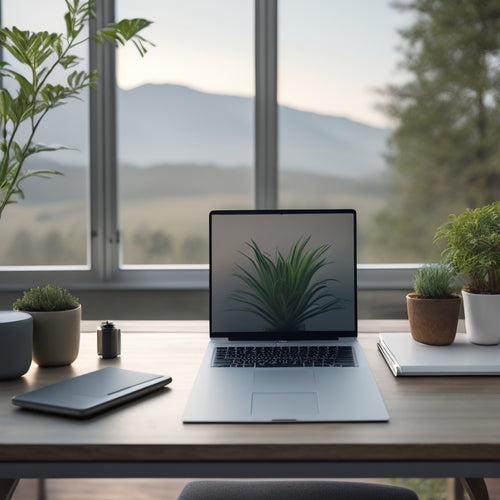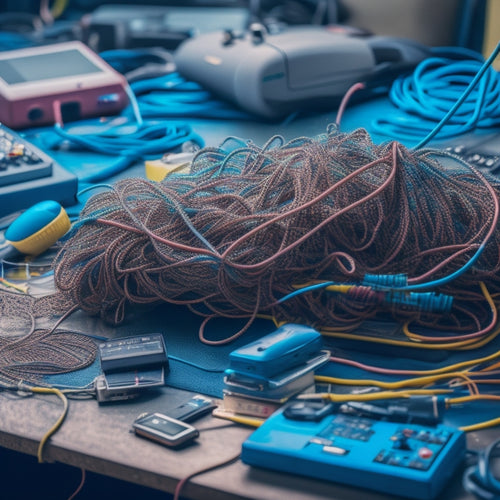
Effortless Kitchen Storage: A Step-by-Step Guide
Share
You're about to change your kitchen into a haven of organization and efficiency, where every utensil, spice, and cookware has its designated place, making meal prep and cleanup a breeze. Start by evaluating your kitchen's storage needs, identifying clutter hotspots, and determining the right shelving materials for your space. Next, design and build your DIY shelving unit, considering factors like shelf size, aesthetic, and weight capacity. With your unit built, prepare the installation site, then install your shelving and backsplash. Finally, add some finishing touches, like functional accessories and decorative trim, to create a kitchen that's not only organized but also visually appealing - and that's just the beginning of your kitchen change.
Key Takeaways
- Assess your current kitchen storage situation to identify areas for improvement and optimize your space.
- Choose the right shelving materials based on durability, aesthetic, weight capacity, budget, and maintenance needs.
- Design a customized shelving unit that fits your kitchen's unique space and style, considering shelf size, configuration, and adjustability.
- Prepare the installation site by clearing clutter, rearranging furniture, and inspecting walls for damage or unevenness.
- Add functional accessories like display racks and storage baskets to enhance organization and create a visually appealing kitchen display.
Assessing Your Kitchen Storage Needs
Take stock of your kitchen's current storage situation to identify areas that need improvement. Assess what's working and what's not, and make a mental note of the problem areas.
Are you constantly rummaging through cluttered cabinets for a specific utensil? Do you struggle to find space for your cookbooks or infrequently used appliances?
By utilizing smart storage solutions, you can maximize your kitchen space and reduce clutter effectively. Additionally, automated inventory tracking can minimize manual checks and prevent stockouts.
By pinpointing these pain points, you'll be able to develop effective kitchen organization tips customized to your specific needs. Decluttering strategies, such as purging unnecessary items and categorizing similar items together, can also help you maximize your kitchen's storage potential.
With a clear understanding of your kitchen's storage needs, you'll be well on your way to creating a more efficient, organized space that makes meal prep a breeze.
Choosing the Right Shelving Materials
With your kitchen's storage needs assessed, it's time to focus on the foundation of your organizational system: shelving. Now, you need to choose the right shelving materials that fit your needs and preferences. Consider the material durability, aesthetic choices, weight capacity, budget considerations, and maintenance needs.
| Material | Durability | Aesthetic |
|---|---|---|
| Wood | High | Traditional, warm |
| Metal | Very High | Modern, sleek |
| Plastic | Medium | Versatile, colorful |
| Glass | High | Sophisticated, refined |
Consider your kitchen's style, the items you'll be storing, and your budget when selecting shelving materials. Don't forget to think about maintenance needs, such as ease of cleaning and resistance to scratches or corrosion. By choosing the right materials, you'll create a functional and stylish shelving system that meets your needs.
Designing Your DIY Shelving Unit
Now that you've chosen the perfect shelving material, it's time to bring your storage vision to life.
You're about to create a functional and stylish DIY shelving unit that optimizes your kitchen space.
To achieve this, consider the following design elements:
-
Measure your kitchen space to determine the ideal shelf size and configuration for maximum space optimization.
-
Decide on the number of shelves you need, factoring in the items you want to store and their respective sizes.
-
Choose a shelf aesthetics that complements your kitchen's style and decor.
-
Plan for adjustable shelves to accommodate items of varying heights.
-
Consider adding decorative trim or molding to conceal screws or other hardware.
Preparing the Installation Site
You've finalized your DIY shelving design, and it's time to prep the installation site. Before you start building, verify the area is clear of clutter and obstructions.
Remove any items from the walls, floors, and countertops to create a clean slate. Take this opportunity to optimize your space by rearranging furniture or appliances to make the most of your kitchen's layout.
Measure the area again to double-check your design fits perfectly. During site preparation, inspect the walls for any damage or unevenness that might affect your shelving unit's stability.
Make any necessary repairs before moving forward. With a well-prepared site, you'll be able to focus on a smooth and efficient installation process.
Building Your Shelving Unit
Your DIY shelving design is finally taking shape as you begin building your shelving unit. You've chosen your materials, and now it's time to bring your vision to life.
Consider the following key elements to guarantee your shelving unit meets your kitchen storage needs:
-
Shelving styles: Decide on the type of shelving you want, such as fixed, adjustable, or floating shelves, to maximize storage and accessibility.
-
Wall options: Choose the right wall anchors, such as screws or adhesive strips, to securely fasten your shelving unit to the wall.
-
Shelf depth: Determine the ideal shelf depth to accommodate your kitchen items, guaranteeing easy access and visibility.
-
Support brackets: Add support brackets to prevent shelves from sagging or collapsing under heavy loads.
-
Finishing touches: Consider adding decorative trim or molding to conceal any gaps or rough edges, giving your shelving unit a polished look.
Installing Shelving Unit and Backsplash
With your shelving unit built, it's time to bring it into your kitchen. Carefully move it into position, ensuring it's level and secure.
Install the shelves according to your chosen shelving style, whether that's fixed, adjustable, or a combination of both.
Next, turn your attention to the backsplash. Choose from a variety of backsplash materials, such as tile, glass, or stainless steel, to complement your kitchen's aesthetic.
Measure and cut the material to fit your space, then install it according to the manufacturer's instructions.
Make sure it's securely fastened to the wall to prevent damage or water seepage.
Final Touches and Accessories
You've finally reached the finishing touches of your kitchen storage project!
Now it's time to add some functional flair with accessories that showcase your kitchen essentials and keep clutter at bay.
You'll want to contemplate installing display racks, storage baskets, and shelves to keep your kitchen organized and stylish.
Kitchen Essentials Display
Beyond the functional storage solutions, a kitchen essentials display adds a touch of personality to your cooking space.
You can create a visually appealing display that showcases your favorite kitchen items, such as cookbooks, vintage utensils, or a statement piece of artwork.
To achieve a cohesive look, consider a minimalist approach to functional decor.
- Group similar items together, like all your cookbooks or all your vintage utensils.
- Choose a few statement pieces that reflect your personal style.
- Consider the scale of the items and the space available.
- Don't overcrowd the display, as this can create visual clutter.
- Play with different heights and textures to add depth and interest.
Storage Baskets and Shelves
Storage baskets and shelves serve as the final touches and accessories to your kitchen storage system, adding a polished look while keeping essentials within easy reach.
You've worked hard to create a functional space, and now it's time to add the finishing touches. Consider basket organization for items like spices, oils, or snacks. Choose baskets that fit your kitchen's style and install them on shelves or in cabinets.
Shelf aesthetics matter too - opt for shelves that complement your kitchen's color scheme and style.
Frequently Asked Questions
Can I Use Reclaimed Wood for My DIY Shelving Unit?
You can definitely use reclaimed wood for your DIY shelving unit, but first, you'll need to source high-quality reclaimed wood and consider wood treatment options to guarantee durability and a beautiful finish.
How Do I Prevent My Shelves From Becoming Cluttered Again?
You'll maintain clutter-free shelves by implementing shelf organization strategies, like categorizing items, using storage bins, and designating zones, while practicing consistent clutter management habits, such as regular cleaning and mindful item placement, to keep your space organized.
Are Adjustable Shelves Necessary for a Functional Kitchen?
You'll be surprised to know that 75% of homeowners wish they had more kitchen storage space! While adjustable shelves aren't a must, they offer flexibility and customization, allowing you to maximize your kitchen's potential and maintain organization with ease.
Can I Add Decorative Trim to My Shelving Unit?
You can add decorative trim to your shelving unit to enhance its style. Choose from various decorative styles, such as modern, rustic, or traditional, and select trim materials like wood, metal, or PVC to match your kitchen's aesthetic.
Will My DIY Shelving Unit Affect My Kitchen's Resale Value?
When selling your home, you'll want to evaluate how your DIY shelving unit impacts resale value. Stay on top of resale trends and buyer preferences to guarantee your design choices appeal to potential buyers and maximize your sale price.
Related Posts
-

Streamline Your Digital Life: Online Courses to Help
You're feeling overwhelmed by digital clutter, and it's time to take control. Online courses can help you streamline ...
-

What's Holding You Back From Digital Simplicity?
You're struggling to achieve digital simplicity due to fear of overwhelm from technology anxiety, information overloa...
-

What Are the Best Compact Smart Kitchen Appliances?
When it comes to compact smart kitchen appliances, you'll want to prioritize energy efficiency, space-saving design, ...


